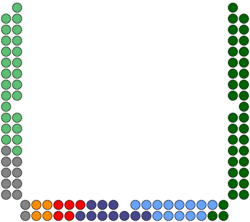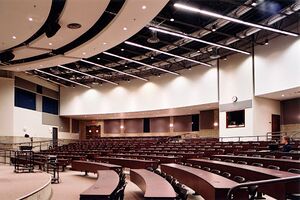State Council: Difference between revisions
No edit summary |
m (fixed template) |
||
| (13 intermediate revisions by the same user not shown) | |||
| Line 16: | Line 16: | ||
| house_type = Upper House | | house_type = Upper House | ||
| body = Hérvynsken | | body = Hérvynsken | ||
| foundation = {{Start date| | | foundation = {{Start date|1978|}} | ||
| disbanded = <!--{{End date|YYYY|MM|DD}}--> | | disbanded = <!--{{End date|YYYY|MM|DD}}--> | ||
| preceded_by = | | preceded_by = | ||
| Line 27: | Line 27: | ||
| leader2_type = Leader of the State Council | | leader2_type = Leader of the State Council | ||
| leader2 = John Lobjons | | leader2 = John Lobjons | ||
| party2 = [[ | | party2 = [[Socialist Party (Seketan)|Socialist]] | ||
| election2 = {{Start date|2021|05|1}} | | election2 = {{Start date|2021|05|1}} | ||
| seats = 106 State Representatives | | seats = 106 State Representatives | ||
| structure1 = | | structure1 = File:Seketan Senators Mar2023.png | ||
| structure1_res = 250px | | structure1_res = 250px | ||
| political_groups1 = | | political_groups1 = {{template:State_Council_structure}} | ||
| voting_system1 = * 56 appointed by state governments as general representatives<br /> | |||
| voting_system1 | |||
* 50 seats appointed by state governments as experts in 9 ministries | * 50 seats appointed by state governments as experts in 9 ministries | ||
| last_election1 = | | last_election1 = [[2023 Seketese Local Elections|6 March 2023]] | ||
| next_election1 = | | next_election1 = [[Next Seketese General Election|Before March 4, 2025]] | ||
| session_room = | | session_room = File:CommonsCounilInteriror.jpg | ||
| session_res = | | session_res = | ||
| session_alt = | | session_alt = | ||
| meeting_place = | | meeting_place = [[Hérvynsken Building]] <br/> | ||
Government District, Conelibek, Seketan | |||
| session_room2 = | | session_room2 = | ||
| session_res2 = | | session_res2 = | ||
| Line 59: | Line 49: | ||
| footnotes = | | footnotes = | ||
}} | }} | ||
{{Template:Politics of Seketan}} | |||
The '''State Council''', often referred to as the '''Council''' is the upper house of the Seketese [[Hérvynsken]] tha represents the 7 provincial governments of [[Seketan]]. The Council meets in the former Royal Chambers of the [[Hérvynsken Building]] in Conelibek. The current President of the Council is Ajek Denn since February 2019. | The '''State Council''', often referred to as the '''Council''' is the upper house of the Seketese [[Hérvynsken]] tha represents the 7 provincial governments of [[Seketan]]. The Council meets in the former Royal Chambers of the [[Hérvynsken Building]] in Conelibek. The current President of the Council is Ajek Denn since February 2019. | ||
The Council is the less | The Council is the less powerful of the Hérvynsken. Only the lower [[Commons Council (Seketan)|Commons Council]] can introduce money bills and votes of non-confidence, and any bill unrelated to the [[Seketese Constitution]] or the powers of the provinces only needs approval from the Commons. Inspired by the {{wp|German Bundesrat}}, most of its members are {{wp|Ex officio member|ex officio}} through their respective provincial ministries. These members often send deputies to serve while they are busy in their home province. | ||
Membership in the council is very fluid as all the members are appointed by provincial governments. The political makeup usually changes | Membership in the council is very fluid as all the members are appointed by provincial governments. The political makeup usually changes when a new provincial government is created after provincial elections. Each province's delegations are representative of the government, with general and expert seats distributed to governing parties. Due to this lack of direct elections, the Council is a continuous body without set sessions. Even when the Commons is dissolved for a general election the Council's committees often continue to conduct its business. | ||
=History= | |||
==Precersors== | |||
While the [[Commons Council (Seketan)|Commons Council]] has existed essentially continuously since 1799, Seketan's upper house has changed a lot during its evolution of government. Under the [[Kingdom of Seketan]] it was known as the [[House of Elders (Seketan)|House of Elders]] and was made up of the monarch's closest nobels, forming the monarch's court. Over time it would reform itself into an appointed house similar to the UK's {{wp|House of Lords}} until 1884 when it was abolished when Seketan was merged into the [[Nelbec Empire]]. | |||
After the [[Seketese Revolution]] and subsequent [[Seketese Civil War|civil war]], the [[Second Seketese Republic]] was established with the upper house taking on its current name, the State Council. From 1924 to 1925 the council was split between Seketese and Wilsk representatives, however, in 1926 this system was abolished in favour of a 21-person appointed council. In 1945 with the formation of the [[Third Seketese Republic]] it was abolished completely, leaving Seketan with a unicameral legislature until 1978. | |||
==Post-Revolution== | |||
Lorem ipsum dolor sit amet, consectetur adipiscing elit. Suspendisse et velit enim. Praesent iaculis interdum ante, non elementum sem tristique a. In consectetur justo ut libero convallis, sed iaculis ex varius. Cras vitae nulla elit. Maecenas eget sagittis sapien. Pellentesque id diam a sem laoreet ornare quis non sem. Etiam et odio leo. In ut finibus massa. Etiam tristique rhoncus dapibus. Donec vulputate gravida neque sed tempor. Pellentesque elementum nisl sem, non semper orci sagittis in. Maecenas aliquam orci velit, vitae finibus massa rutrum vitae. Sed tempor, felis vitae aliquet congue, nisl erat ultricies ante, a pharetra est libero eget est. Donec condimentum varius arcu, in accumsan nibh euismod id. Aenean consectetur eget magna vitae mollis. Maecenas eros ante, sodales in orci et, efficitur tempus ligula. | |||
Quisque semper orci non neque tincidunt, ut molestie libero condimentum. Duis consectetur sem mi, eget porttitor elit posuere at. In hac habitasse platea dictumst. Maecenas eleifend dictum faucibus. Proin ex dui, consectetur eu auctor quis, posuere vel tortor. Morbi ac mauris id metus condimentum fermentum. Praesent consectetur lorem justo, ut viverra tortor sagittis a. Duis ut odio at ante lacinia lacinia eu dapibus enim. Pellentesque eget ex pharetra, consectetur leo a, molestie dui. Nunc sollicitudin sodales tellus, quis venenatis metus mollis non. Ut purus risus, placerat eu magna nec, varius molestie orci. | |||
=Structure= | |||
The structure of the State Council is heavily inspired by the {{wp|German Bundesrat}} and the {{wp|Senate of Canada|Canadian Senate}}. Membership in the Council is split into two groups, 50 General Representatives and 56 Expert Representatives. Each group has special powers and responsibilities and meets together collectively as the State Council. All members are appointed to their position by their respective Provincial Governments. | |||
=Notes= | |||
{{notelist}} | |||
{{Seketan topics}} | |||
Latest revision as of 22:57, 19 July 2023
This article is incomplete because it is pending further input from participants, or it is a work-in-progress by one author. Please comment on this article's talk page to share your input, comments and questions. Note: To contribute to this article, you may need to seek help from the author(s) of this page. |
State Council | |
|---|---|
| Type | |
| Type | Upper House of the Hérvynsken |
| History | |
| Founded | 1978 |
| Leadership | |
President | Ajek Denn, Socialist since February 14, 2019 |
Leader of the State Council | John Lobjons, Socialist since May 1, 2021 |
| Structure | |
 | |
Political groups | Government (26)
Confidence and Supply (10) Opposition (120)
|
| Elections | |
| |
Last election | 6 March 2023 |
Next election | Before March 4, 2025 |
| Meeting place | |
 | |
| Hérvynsken Building Government District, Conelibek, Seketan | |
 |
|---|
| This article is part of a series on the politics and government of Seketan |
The State Council, often referred to as the Council is the upper house of the Seketese Hérvynsken tha represents the 7 provincial governments of Seketan. The Council meets in the former Royal Chambers of the Hérvynsken Building in Conelibek. The current President of the Council is Ajek Denn since February 2019.
The Council is the less powerful of the Hérvynsken. Only the lower Commons Council can introduce money bills and votes of non-confidence, and any bill unrelated to the Seketese Constitution or the powers of the provinces only needs approval from the Commons. Inspired by the German Bundesrat, most of its members are ex officio through their respective provincial ministries. These members often send deputies to serve while they are busy in their home province.
Membership in the council is very fluid as all the members are appointed by provincial governments. The political makeup usually changes when a new provincial government is created after provincial elections. Each province's delegations are representative of the government, with general and expert seats distributed to governing parties. Due to this lack of direct elections, the Council is a continuous body without set sessions. Even when the Commons is dissolved for a general election the Council's committees often continue to conduct its business.
History
Precersors
While the Commons Council has existed essentially continuously since 1799, Seketan's upper house has changed a lot during its evolution of government. Under the Kingdom of Seketan it was known as the House of Elders and was made up of the monarch's closest nobels, forming the monarch's court. Over time it would reform itself into an appointed house similar to the UK's House of Lords until 1884 when it was abolished when Seketan was merged into the Nelbec Empire.
After the Seketese Revolution and subsequent civil war, the Second Seketese Republic was established with the upper house taking on its current name, the State Council. From 1924 to 1925 the council was split between Seketese and Wilsk representatives, however, in 1926 this system was abolished in favour of a 21-person appointed council. In 1945 with the formation of the Third Seketese Republic it was abolished completely, leaving Seketan with a unicameral legislature until 1978.
Post-Revolution
Lorem ipsum dolor sit amet, consectetur adipiscing elit. Suspendisse et velit enim. Praesent iaculis interdum ante, non elementum sem tristique a. In consectetur justo ut libero convallis, sed iaculis ex varius. Cras vitae nulla elit. Maecenas eget sagittis sapien. Pellentesque id diam a sem laoreet ornare quis non sem. Etiam et odio leo. In ut finibus massa. Etiam tristique rhoncus dapibus. Donec vulputate gravida neque sed tempor. Pellentesque elementum nisl sem, non semper orci sagittis in. Maecenas aliquam orci velit, vitae finibus massa rutrum vitae. Sed tempor, felis vitae aliquet congue, nisl erat ultricies ante, a pharetra est libero eget est. Donec condimentum varius arcu, in accumsan nibh euismod id. Aenean consectetur eget magna vitae mollis. Maecenas eros ante, sodales in orci et, efficitur tempus ligula.
Quisque semper orci non neque tincidunt, ut molestie libero condimentum. Duis consectetur sem mi, eget porttitor elit posuere at. In hac habitasse platea dictumst. Maecenas eleifend dictum faucibus. Proin ex dui, consectetur eu auctor quis, posuere vel tortor. Morbi ac mauris id metus condimentum fermentum. Praesent consectetur lorem justo, ut viverra tortor sagittis a. Duis ut odio at ante lacinia lacinia eu dapibus enim. Pellentesque eget ex pharetra, consectetur leo a, molestie dui. Nunc sollicitudin sodales tellus, quis venenatis metus mollis non. Ut purus risus, placerat eu magna nec, varius molestie orci.
Structure
The structure of the State Council is heavily inspired by the German Bundesrat and the Canadian Senate. Membership in the Council is split into two groups, 50 General Representatives and 56 Expert Representatives. Each group has special powers and responsibilities and meets together collectively as the State Council. All members are appointed to their position by their respective Provincial Governments.